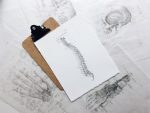Spine Surgery Effective in SMA Type 1 Children, But Not Without Risks

Surgery to correct kyphoscoliosis — a combination of two types of abnormal curvature of the spine — allows the successful delivery of Spinraza (nusinersen) into the spinal canal of children with spinal muscular atrophy (SMA) type 1, a case series study shows.
However, post-surgery complications occurred in all four described cases, with each child — who ranged in age from 3 to 7 — subsequently needing additional spinal surgeries. A five-year-old patient required six revision surgeries over five months.
These findings highlight the feasibility of kyphoscoliosis surgery in this patient subgroup, according to researchers, who note that these types of interventions are increasingly needed due to the prolonged survival of children with SMA given the availability of recent disease-modifying treatments.
Given the risk of surgical and post-surgery complications and prolonged recovery, physicians should discuss, thoroughly, the risks and benefits of such procedures with each patient’s parents or caretakers before a decision is made, the researchers said.
The study, “A case series of paediatric patients with spinal muscular atrophy type I undergoing scoliosis correction surgery,” was published in the journal Anaesthesia Reports.
Scoliosis, an abnormal and progressive sideways curvature of the spine — in which the spine forms an “S” shape when viewed from behind — is a common health problem faced by SMA patients, especially those with more severe disease types, such as types 1 and 2.
Other abnormal curvatures may also occur, such as lordosis, an excessive inward bend of the spine, and kyphosis, an outward curve, sometimes called hunchback. Kyphoscoliosis, the type treated here, is a combination of scoliosis and kyphosis.
Each of these spinal curvatures, which can affect movement and breathing, are caused by SMA-associated weakness in the muscles of the back that support the spine’s position.
Treatment options range from more conservative methods, such as wearing braces and assistive devices, to more invasive strategies such as surgery. The aim in surgery is to lessen the spinal curvature and prevent it from worsening, rather than just treating the symptoms.
The approval of Spinraza as the first disease-modifying therapy for SMA has significantly improved the life expectancy of children with severe type 1 disease — who previously did not usually survive past age 2. Spinraza was approved in 2016 in the U.S. and in 2017 in Europe.
With increased survival, children with type 1 are now experiencing symptoms and complications not previously seen in this group of patients, including kyphoscoliosis, a combination of two types of abnormal spinal curvature.
Now, researchers at Children’s Health Ireland at Temple Street, in Dublin, described the cases of four children with SMA type 1 who underwent kyphoscoliosis correction surgery at their hospital between July 2020 and June 2021.
The surgery involved the placement of growing rods to the top and bottom of the spine with screws or hooks to force the spine to remain straight. These rods can be further lengthened with subsequent surgeries as the child grows.
Given that this type of surgery changes the patient’s anatomy and may challenge spinal injections, rod positioning was carefully planned to facilitate ongoing Spinraza treatment, which is administered directly into the spinal canal three times a year.
The children were ages 3, 4, 5, and 7, and all needed non-invasive ventilatory support at night. Each of the children had been hospitalized in the prior year due to respiratory problems.
The youngest child experienced difficulties in mechanical ventilation during surgery, but these were successfully resolved with suctioning of respiratory secretions. No other surgical or post-operative respiratory complications were reported.
The patients each were followed in the pediatric intensive care unit for one to two days after surgery and discharged home after about a week (range, six to 11 days).
All had post-surgery complications that required additional surgical interventions; in total, the four children underwent 15 spinal surgeries, ranging from two to six procedures over several months.
These complications included cerebrospinal fluid (CSF) leak, metal frame exposure, pain, spinal instability, rod penetration into the spinal canal, poor wound healing, and wound infection. The CSF is the fluid that surrounds the brain and spinal cord.
Poor bone health was detected in one child during the first revision surgery, and an investigation into possible osteoporosis — a condition that causes bones to become weaker and more fragile — is ongoing.
This child required multiple revision surgeries, as the rods kept slipping off the bone-anchoring sites.
“There is increasing evidence that patients with SMA have underlying abnormal bone density,” the researchers wrote, adding that nutritional deficiencies and reduced muscle mass commonly seen in these patients also may contribute to bone problems.
Hormonal analysis should be considered before surgery if there is any concern for gradual loss of bone density, the team noted.
After surgery, all children underwent successful Spinraza injection with an image-guided method called fluoroscopy.
These findings highlight the feasibility and potential complications of kyphoscoliosis correction surgery in children with SMA type 1, the researchers noted.
“With the risk of a prolonged recovery, surgical and anesthetic complications, a detailed discussion regarding risks and benefits must be had with the guardian before undertaking such procedures,” the researchers wrote.
The post Spine Surgery Effective in SMA Type 1 Children, But Not Without Risks appeared first on SMA News Today.




